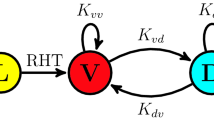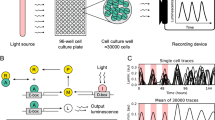Abstract
Adaptive characteristics of circadian rhythm are based on their capacity to be synchronized by external signals, particularly light signals. The effect of both single and periodic light signals on the electroretinogram (ERG) circadian rhythm in crayfish is studied. In a previous work (Lara-Aparicioet al., Bull math. Biol. 55, 97–110, 1993) we developed a mathematical model simulating the emergence of the ERG circadian rhythm during the ontogeny of the crayfish. In the present work we have tested the familiar wave-shift behaviour of an oscillator with a single limit cycle. Two new facts, not present in a simpler model, now appear, which simulate adequately the experimental results, i.e. the presence of a transient stage and the shape of the perturbed wave which changes according to the characteristics of the external light signals.
Similar content being viewed by others
Literature
Aschoff, J. 1960. Exogenous and endogenous components in circadian rhythms.Cold Spring Harbor Symp. Quant. Biol. 25, 11–28.
Aschoff, J. 1965. Response curves in circadian periodicity. InCircadian Clocks, pp. 95–111. Amsterdam: North-Holland.
De Coursey, P. J. 1972. LD ratios and the entrainment of circadian activity in a nocturanl and a dirunal rodent.J. comp. Physiol. 78, 223–235.
Enright, J. T. 1965. Synchronization and ranges of entrainment. InCircadian Clocks, pp. 112–124. Amsterdam: North-Holland.
Faniul-Moles, M. L., E. Moreno-Sáenz, N. Villalobos-Hiriart and B. Fuentes-Pardo. 1987. ERG circadian rhythm in the course of ontogeny in crayfish.Comp. Biochem. Physiol.,88A, 213–219.
Fanjul-Moles, M. L., M. Miranda-Anaya and B. Fuentes-Pardo. 1992. Effect of monochromatic light upon the ERG circadian rhythm during ontogeny in crayfish (Procambarus clarki).Comp. Biochem. Physiol.,102A, 99–106.
Fuentes-Pardo, B. and M. C. García. 1979. Effect of light deprivation on the neurohumoral activity of the visual system of the crayfish.Comp. Biochem. Physiol. 64A, 649–655.
Fuentes-Pardo, B. and J. Ramos-Carvajal. 1983. The phase response curve of electroretinographic circadian rhythm of crayfish.Comp. Biochem. Physiol.,74A, 711–714.
Fuentes-Pardo, B., M. L. Fanjul-Moles and E. Moreno-Sáenz. 1992. Synchronization by light of the ERG circadian rhythm during ontogeny in the crayfish.J. interdiscipl. Cycle Res 23, 81–91.
Hernández-Falcón, J., E. Moreno-Sáenz, J. M. Farías and B. Fuentes-Pardo. 1987. Role of the sinus gland on crayfish circadian rhythmicity. I. Pseudopupil circadian rhythm.Comp. Biochem Physiol. 87A, 111–118.
Kalmus, H. and L. A. Wigglesworth. 1960. Shock excited systems as models for biological rhythms.Cold Spring Harbor Symp. Quant. Biol.,25, 211–216.
Kawato, M. 1981. Transient and steady state phase response curves of limit cycles oscillators.J. math. Biol. 12, 13–30.
Kleinholz, L. H., 1934. Eye-stalk hormone and the movement of distal retinal pigment inPlaemonetes.Proc. natn. Acad. Sci. U.S.A. 20, 659–661.
Klotter, K. 1960. Theoretical analysis of some biological models.Cold Spring Harbor Symp. Quant. Biol. 25, 189–196.
Lara-Aparicio, M., S. López de Medrano, B. Fuentes-Pardo and E. Moreno-Sáenz. 1993. A qualitative mathematical model of the ontogeny of a circadian rhythm in crayfish.Bull. math. Biol. 55, 97–110.
Lewis, R. D. and D. S. Saunders. 1987. A damped circadian oscillator model for an insect photoperiodic clock. I. Description of the model based on a feedback control system.J. theor. Biol. 128, 47–59.
Moreno-Sáenz, E., J. Hernández-Falcón and B. Fuentes-Pardo. 1987. Role of the sinus gland on crayfish circadian rhythmicity. II. ERG circadian rhythm.Comp. Biochem. Physiol. 87A, 119–125.
Moreno-Sáenz, E., B. Fuentes-Pardo and J. Hernández-Falcón, 1992. Photoentrainment of the circadian rhythm in the electroretinogram of the crayfish and its dependence on the sinus gland.J. exp. Zool.,264, 144–152.
Pavlidis, T. 1967. A mahematical model for the light affected system in theDrosophila eclosion rhythm.Bull. math. Biophys. 29, 291–310.
Peterson, E. L. 1980. A limit cycle interpretation of a mosquito circadian osillator.J. theor. Biol. 84, 281–310.
Pittendrigh, C. S. 1966a. The circadian oscillation inDrosophila pseudoobscura pupae: A model for the photoperiodic clock.Z. Pflanzenphysiol.,54, 275–307.
Pittendrigh, C. S. and S. Daan. 1976. A functional analysis of circadian pacemakers in nocturnal rodents. I. The stability and lability of spontaneous frequency.J. comp. Physiol,106, 223–252.
Pittendrigh, C. S. and S. Daan. 1976b. A functional analysis of circadian pacemakers in nocturnal rodents. IV. Entrainment: Pacemaker as clock.J. comp. Physiol. 106, 291–331.
Winfree, A. T. 1980.The Geometry of Biological Time. Berlin: Springer-Verlag.
Author information
Authors and Affiliations
Rights and permissions
About this article
Cite this article
Fuentes-Pardo, B., Lara-Aparicio, M. & de Medrano, S.L. Perturbation of a circadian rhythm by single and periodic signals and its mathematical simulation. Bltn Mathcal Biology 57, 175–189 (1995). https://doi.org/10.1007/BF02460614
Received:
Revised:
Issue Date:
DOI: https://doi.org/10.1007/BF02460614




